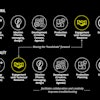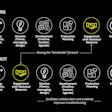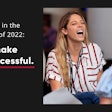
Rohit Talwar is the C.E.O. of United Kingdom–based Fast Future Research, where he applies his skills as a futurist to understand and project what’s ahead for the meeting and event industry. He led the studies Convention 2020 and IMEX Power of 10, which looked into the major factors likely to affect the industry in the years to come.
Summarize the findings of Convention 2020 and Power of 10.
The research highlights that the industry is facing a perfect storm of economic, social, environmental, and technological trends that are changing the face of business and driving client, exhibitor, sponsor, and attendee expectations of business events. Economic uncertainty will be a constant backdrop over the next decade and will change business and delegate behaviors on a permanent basis. Business cycles are getting shorter and faster, lead times for event booking will continue to reduce, and the pressure on budgets isn’t going away any time soon.
The consumerization of technology is turning us all into technology sophisticates and datasexuals. We crave and collect data about ourselves and increasingly want service providers to use it in personalizing the event experience: from the sessions on offer to the food available, we want tailored offerings. There is a growing expectation that technology will be woven seamlessly into event designs and enable delegates to interact with others before, during, and after the experience.
What are the biggest shifts taking place in meeting industry thinking?
We have to stop thinking of our events as one-offs and start to see them as platforms for year-round engagement—the focal point of an ongoing experience. For event owners, we have to look at ways of monetizing the event beyond physical attendance—packaging and reselling event audio, video, and presentation content to those who were unable to attend. The standard event business model of one-price-fits-all will need to evolve, with options such as premium pricing and per-session pricing coming in.
What are the most important emerging meeting trends?
Proving the value of our events at multiple levels. There will be ever-increasing demand to demonstrate the return on the delegates’ emotional, time, and financial investment. At the strategic level, there is a growing understanding that we need to prove the value of business events beyond tourism. The event industry offers a clear platform for information exchange, networking, and value generation—particularly in the knowledge-based industries on which so many economies are pinning their future hopes for growth.
Good business events can help grow key economic sectors such as nanotechnology and biotechnology by bringing national and global players in the industry to the region and putting buyers and suppliers together. They also connect industry investors with local innovators and help in attracting inward investment. And they enable those working in the sector to access the latest industry knowledge, help in attracting funding for local researchers, and connect the local industry to global networks. It is this understanding of the true long-term value of business events that is driving event owners and destinations alike to measure the benefits beyond tourism.
[PULLQUOTE]
What’s the future of meeting technology?
Technology is becoming more personal, wearable, and immersive. We will see an explosion of devices that people bring with them. By 2020, we will have intelligent digital personal assistants guiding us through the day and managing our information flows. Augmented reality, holographic, and 3-D displays will transform how we view data. Our devices will have artificial-intelligence-enabled smart interfaces that offer automatic language translation and support user interaction via gestures, language, and direct-thought transfer. Event owners will need to create apps and services that can be accessed across a range of platforms and that take account of the features coming through. Audiovisual displays will become more immersive and multisensory, touching all of our senses. There will be a growing focus on capturing and repurposing both the structured and unstructured knowledge, such as conversations that are shared at events.
How will the global economy affect meetings in the coming months and years?
Nervousness will continue as a series of shocks continue to drive turbulence in the global economy. Some countries could collapse under their debt burdens, and these failures could drive a series of global and regional recessions. As a result, firms will be reluctant to invest, and decision-making will become more protracted. Planning cycles could keep compressing as firms leave decision-making on events to the last minute. Event industry firms will need to adapt to this changing model and develop systems and staffing models that enable them to be more flexible. There will be a strong focus on value and cost reduction, and the event industry will be driven to innovate and create new propositions to avoid being forced into a race to the bottom on pricing. Inevitably, those who fail to innovate and create new business models will go to the wall. There are particular concerns over venues and convention and visitor bureaus that rely heavily on local or national government subsidies in struggling mature economies. They are being driven to create new business models, which can ensure they are self-funding over time.
What will be the biggest challenges?
The industry has to increase its investment in talent—attracting and developing people who can think strategically and drive the innovations that will ensure the sector thrives even in turbulent times. The next challenge is to develop a longer-term approach, building a deeper understanding of the forces and trends shaping the strategies of the industries we serve, and evolving meeting propositions that address those sector’s needs in a strategic manner. Another priority will be increasing flexibility: in event design, in business models, in the way we use venue space, and in the way we respond to changing needs.
What can planners do to keep up with the changes?
The best have an excellent ecosystem of support mechanisms in place to help them stay abreast of developments that could have an impact over the short, medium, and longer term. They tend to be active on industry social networks, where they ask for help and share what they are learning. Many devote time to regular reading, both of meeting industry publications, blogs, and reports, and also of content from the sectors they work with. Attendance at a wide range of live and virtual seminars and networking forums is an important source of knowledge. The challenge is to acknowledge that with an ever-quickening pace of change and constant innovation, we have to spend more time staying abreast and investing in our own lifelong learning.



















